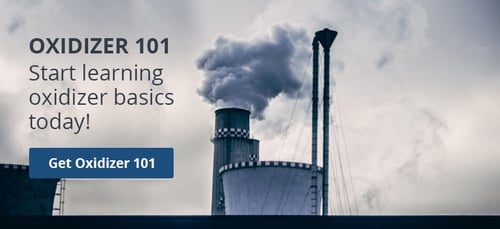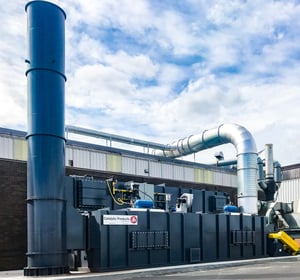Regenerative Thermal Oxidizer (RTO)
What is a Regenerative Thermal Oxidizer?
A Regenerative Thermal Oxidizer (RTO) is an air pollution control device that destroys volatile organic compounds (VOCs), hazardous air pollutants (HAPs), and odors by converting the solvent-laden emissions into CO2 and H2O through the use of heat before exhausting them to the atmosphere.
RTOs play a crucial role promoting sustainability in industrial practices by reducing emissions, conserving resources, and minimizing environmental impact.
Regenerative Thermal Oxidizers significantly reduce harmful emissions from industrial processes resulting in cleaner air and mitigating the impact on public health and the environment.
Regenerative Thermal Oxidation is designed to maximize energy efficiency through heat recovery methods. An RTO oxidizer utilizes the heat generated during the oxidation process to preheat the incoming process streams, reducing the overall energy requirements of industrial processes.
With standard two-chamber RTO air volumes ranging from 2,000 scfm up to 80,000 scfm the CPI Regenerative Thermal Oxidizer (RTO) provides maximum capacity and flexibility. For applications in excess of 80,000 scfm, CPI offers the ability to operate two RTOs in tandem, or to pair a Rotary Concentrator System with a smaller RTO to optimize air volume. With these combinations CPI has installed Regenerative Thermal Oxidizer (RTO) systems for process air volumes up to 180,000 scfm.
Thermal efficiencies up to 97% and destruction efficiencies that can exceed 98% for two-chamber Regenerative Thermal Oxidizers result in the most efficient air pollution control device.
A VOC entrapment chamber can be added to the two chamber RTO oxidizer to achieve 99% DRE. For 99.9% destruction of VOCs, a 3-chamber RTO is often applied for odor related applications.
Regenerative Thermal Oxidizer (RTO) Frequently Asked Questions:
How is a Regenerative Thermal Oxidizer Designed?
RTO oxidizers are considered among the world's most advanced thermal oxidation systems. With thermal efficiencies of up to 97%, and destruction efficiencies that can exceed 98%, a Regenerative Thermal Oxidizer (RTO) will give you the highest possible removal rates at the lowest full lifecycle cost relative to other thermal oxidizers
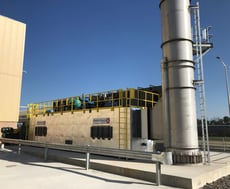 As a Regenerative Thermal Oxidizer (RTO) manufacturer, CPI engineers and builds to your specifications – matched to industry-leading construction and design features, all resulting in exceptional performance, substantially reduced operating costs, and industry-leading reliability.
As a Regenerative Thermal Oxidizer (RTO) manufacturer, CPI engineers and builds to your specifications – matched to industry-leading construction and design features, all resulting in exceptional performance, substantially reduced operating costs, and industry-leading reliability.
We begin with three basic models that offer varying levels of VOC destruction and energy efficiency. We then take into consideration the particular characteristics of your air stream, such as quantity, temperature, composition of VOCs, and the possibility of incorporating energy conservation into the process.
These specially designed, cost-effective, proven systems combine the basic principles of thermal oxidizer design; Time, Temperature, and Turbulence.
- Time. Retention time, or residence time, is the length of time that a VOC/organic is at the appropriate oxidation temperature. Both retention time and residence time refer to time inside the thermal oxidizer's combustion chamber.
- Temperature. Typical temperatures in the combustion chamber range between 1400°F and 1600°F and higher. For each organic, a specific temperature and a specific retention time is required to achieve the desired level of destruction.
- Turbulence. Sufficient air mixing, also known as turbulence, must also be achieved in the combustion chamber.
Back to RTO questions
What is the Cost of a Regenerative Thermal Oxidizer?
The capital investment for an RTO includes the equipment cost, the cost of auxiliary equipment (e.g. ductwork, product options), and all direct and indirect installation costs. The higher capital costs of these units can be substantially offset by the substantial savings in auxiliary fuel costs. The cost of an RTO is influenced by the exhaust stream volumetric flow rate, VOC loading and desired destruction rate efficiency.
Back to RTO questions

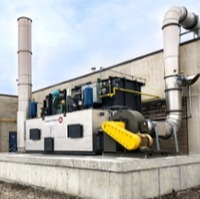

.jpg?width=869&name=How%20an%20RTO%20Works%20(no%20text).jpg)
 CPI RTOs are custom designed for the highest reliability with the lowest overall costs. The complete system is designed with a modular approach for the most cost-efficient solution. The typical CPI RTO is supplied as a 2-tower regenerator system fitted to our EvenFlo Valve Manifold. This modular approach satisfies your needs for a competitive installation cost and ensures that the Posi-Seal poppet valves are properly installed and aligned prior to leaving the factory.
CPI RTOs are custom designed for the highest reliability with the lowest overall costs. The complete system is designed with a modular approach for the most cost-efficient solution. The typical CPI RTO is supplied as a 2-tower regenerator system fitted to our EvenFlo Valve Manifold. This modular approach satisfies your needs for a competitive installation cost and ensures that the Posi-Seal poppet valves are properly installed and aligned prior to leaving the factory. Complementing the regenerator design is our unique cold face support system. While other systems merely rely on a perforated plate to support the ceramic media, CPI RTO systems use a superior supporting grid that allows the lowest pressure drops and highest structural integrity. Based on the application needs, the CPI RTO can be supplied with stainless steel metallurgy to resist chemical attack or added thermal stresses.
Complementing the regenerator design is our unique cold face support system. While other systems merely rely on a perforated plate to support the ceramic media, CPI RTO systems use a superior supporting grid that allows the lowest pressure drops and highest structural integrity. Based on the application needs, the CPI RTO can be supplied with stainless steel metallurgy to resist chemical attack or added thermal stresses. Posi-Seal poppet valves are designed to take advantage of a vertical axis that allows for soft seating action with self-centering guidance. The innovative feature of all Posi -Seal poppet valves is the air-tight machined seal that eliminates valve bypass and maintenance-intensive gaskets. The Posi-Seal poppet valve will be pneumatically operated and will cycle open or closed based on the program logic called for in your application.
Posi-Seal poppet valves are designed to take advantage of a vertical axis that allows for soft seating action with self-centering guidance. The innovative feature of all Posi -Seal poppet valves is the air-tight machined seal that eliminates valve bypass and maintenance-intensive gaskets. The Posi-Seal poppet valve will be pneumatically operated and will cycle open or closed based on the program logic called for in your application. CPI RTO systems incorporate shaft and bearing cooling systems. This simple yet often overlooked feature provides a cool supply of air in the bearing tube and on the bearings. This prevents leakage of the higher pressure air on the inside of the oxidizer from escaping to the atmosphere and helps cool the shaft and bearings for long life.
CPI RTO systems incorporate shaft and bearing cooling systems. This simple yet often overlooked feature provides a cool supply of air in the bearing tube and on the bearings. This prevents leakage of the higher pressure air on the inside of the oxidizer from escaping to the atmosphere and helps cool the shaft and bearings for long life. The CPI RTO is internally insulated with ceramic insulating modules. This system provides low shell temperatures and helps to retain heat for improved efficiency.
The CPI RTO is internally insulated with ceramic insulating modules. This system provides low shell temperatures and helps to retain heat for improved efficiency.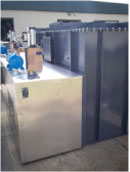 In some cases, the EvenFlo Manifold can be insulated to ensure that the pollutants that enter the oxidizer remain in a gaseous state. If the process constituents should condense at some point in the oxidizer, they can become a
In some cases, the EvenFlo Manifold can be insulated to ensure that the pollutants that enter the oxidizer remain in a gaseous state. If the process constituents should condense at some point in the oxidizer, they can become a 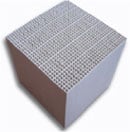 Each CPI Regenerative Thermal Oxidizer system is designed around the particular ceramic heat transfer matrix recommended for the application. CPI RTO systems can be designed using a layered structural ceramic media or a mix of structured and random media (saddles), depending on your application's requirements. The thermal heat transfer model is the key to a well designed and efficient system. With
Each CPI Regenerative Thermal Oxidizer system is designed around the particular ceramic heat transfer matrix recommended for the application. CPI RTO systems can be designed using a layered structural ceramic media or a mix of structured and random media (saddles), depending on your application's requirements. The thermal heat transfer model is the key to a well designed and efficient system. With  Every CPI RTO system is integrated with our customized programmable logic controller PLC-control panel called Temperature Safety System (TSS) Control. TSS communicates with the CPI RTO system and your process for optimal performance, safety and reliability. We use our proprietary thermal control logic and multiple temperature inputs to maximize the regenerator's thermal efficiency. This unique control technique constantly adjusts valve timing to maximize thermal efficiency without compromise in destruction efficiency. No other supplier goes to these extremes to maximize the performance of their RTO.
Every CPI RTO system is integrated with our customized programmable logic controller PLC-control panel called Temperature Safety System (TSS) Control. TSS communicates with the CPI RTO system and your process for optimal performance, safety and reliability. We use our proprietary thermal control logic and multiple temperature inputs to maximize the regenerator's thermal efficiency. This unique control technique constantly adjusts valve timing to maximize thermal efficiency without compromise in destruction efficiency. No other supplier goes to these extremes to maximize the performance of their RTO.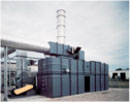 Metallurgical conformity and assessment process to ensure corrosion, and thermally resistant materials are used throughout the regenerative thermal oxidizer system.
Metallurgical conformity and assessment process to ensure corrosion, and thermally resistant materials are used throughout the regenerative thermal oxidizer system. A
A 
